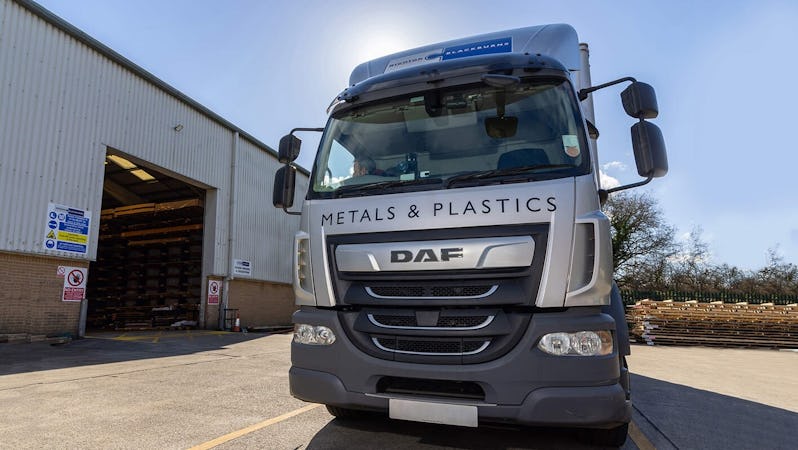Able to create flowing and intricate shapes while maintaining material strength and form, PETG is a tough, clear material that offers many solutions for both indoor and outdoor applications.
Our PETG sheets are especially light, break and impact-resistant even at low temperatures. They are also weather-resistant and highly transparent. These sheets are easily printable and highly suitable for food-contact applications.
These versatile co-polyester sheets combine superior thermoforming properties with very good mechanical characteristics. Because they can easily be thermoformed, energy consumption is reduced whereas productivity remains high.
PETG sheets can be formed into any desired shape, they are easy to mould, and do not require pre-drying before use. As a result, they offer almost unlimited freedom of design when making three-dimensional parts. Shorter production times and less material wastage help mean greater efficiency and less money, while still creating designs of complexity and substance.
- High impact performance allows the application of a thinner gauge sheet than with other common materials, this also helps to lower material costs.
- Certified fire classification according to international standards.
- PETG is a safe choice for many applications.
- At the end of its life cycle, PETG can be cleanly sorted and used as a source of energy or recycled.
Range
| Sheet Size | Thicknesses |
|---|---|
2050 x 3050 (Clear) | 3.0mm - 10.0mm |
Other sizes/options available upon request
Properties
| Property | Test Method | Units | Value |
|---|---|---|---|
Physical Properties | |||
Density | ISO 1183 | g/cm3 | 1.27 |
Moisture Abs (24hr/23°C) | ISO 62-4 | % | <0.2 |
Water Solubility | DIN 53122 | Insoluble | |
Mechanical Properties | |||
Tensile Strength at Yield | ISO 527 | MPa | >50 |
Tensile Strength at Break | ISO 527 | MPa | >25 |
Elastic Modulus | ISO 178 | MPa | 2100 |
Notched Izod Impact | ISO 180/1A | J/m | 9 |
Rockwell Hardness (R Scale) | 115 | ||
Optical Properties | |||
Refractive Index | ASTM D542 | % | 1.570 |
Thermal Properties | |||
Vicat Softening Temp | ISO 306(B) | oC | 82 |
Thermal Exp Co-efficient | ISO 75-2 | moC | 0.06 |
Service Temp Range | -20 to 60oC | ||
Electrical Properties | |||
Dielectric Strength | IEC 60243-1 | kV/mm | 16 |
Processing & Handling
Chemical Resistance
PETG is resistant to many chemicals and atmospheric pollutants. Contact with solvents must be avoided.
Fabrication
PETG transparent sheet is easy to handle and very suitable for fabrication, heating and vacuum forming particularly at lower temperatures. It has a wide window of processing conditions enabling complex shapes, whilst maintaining good impact strength. Always ensure adequate allowance for thermal expansion.
Sawing
PETG can be sawn using standard hand tools, circular saws and band saws with carbide-tipped blades for a clean finish. Ensure that the blade is sharp and the material is clamped to prevent vibration which may result in cracking. PETG is notch sensitive which can adversely affect the mechanical properties of the material.
Drilling
When drilling PETG it is recommended to use drill bits designed for plastics. To avoid overheating, it’s best to use compressed air or wide and highly polished flutes. To prevent vibration, which may result in cracking, it’s recommended to clamp the part securely.
Die Stamping
PETG can be die-cut, with excellent results on thinner sheets. Sharpened steel blades up to 2.5mm can be used. The back board must be correctly aligned for a clean cut, with the blade completely traversing the sheet to avoid notches. Ensure adequate allowance for thermal expansion.
Bending
PETG is suitable for cold and hot bending techniques. Cold bending is ideal to create simple shapes. It is recommended to heat sheets above 3mm to produce more complex shapes. The best result is obtained by heating the sheet on both sides using an electric heater. When the optimum temperature is reached (+105°C) the sheet can be bent.
Thermoforming
Due to their excellent flow and mold surface reproduction, PETG sheets can be thermoformed at low temperatures without predrying. Because of its low specific heat capacity, PETG requires little energy for thermoforming.
Bonding
PETG can be easily thermoformed using general forming techniques including thermosforming, vacuum forming and line bending. Marpet-g FS does not require pre-drying and forms between 120-160°C.
Edge Finishing
Following cutting, a good edge finish can be obtained using a suitable polishing paste in conjunction with a medium density Reiter wheel, followed by a soft fabric polishing wheel without paste.
Printing
PETG can be printed with standard screen and digital printers in conjunction with inks that are suitable for use with thermoplastic co-polyesters. It’s recommended to protect the ink from scratches by applying a light coat of clear lacquer. Prior to printing ALWAYS clean the surface with a soft cloth and use ionized air to clear dust.
Installation
Applications must make adequate allowance for thermal movement, nominally 3.5 mm per metre. Adequate clearance must be allowed in the holes drilled for fixing. Sheet lengths have to be limited so that there is no excessive movement at the ends. For example, 1.0mm sheets can be cold curved down to a minimum radius of 150mm. For good design practice it is advised that a 1.0mm flat sheet not be curved below 175mm.
Storage
PETG is best stored indoors under ambient warehouse conditions up to 20°C, away from direct sunlight, in a cool dry store. In case of outdoor storage, additional all-round cover is necessary. The surface masking film should remain on the sheet until it is ready for use. Avoid standing sheets on end.
Applications
Print & Display
- Displays
- Signage
- Illuminated advertising signs
- Point of sale equipment
- Graphic arts
- Poster covers
- Kiosks
- Light boxes
Fabrication
- Vending equipment
- Protective screens
- Shower surrounds
- Industrial trays
- Thermoformed parts
Characteristics
- Good impact resistance
- Excellent thermoforming properties
- Reduced process time
- No pre-drying required
- Optical clarity
- Chemical resistance
- Light transmission
- Durability
- Easily machined and fabricated
- Good fire performance
- Recyclable
- Food safe
- Resistant to weathering
- UV stable (depending on the application)
General Information for PETG
PETG Sustainability
PETG can take decades to degrade entirely and is easily recyclable by being broken down into its base materials and re-formed.
The production of new plastic uses large amounts of energy and water, so plastics that can be recycled such as PETG are a must for energy efficiency and reducing the consumption of natural resources.
PETG, if allowed to degrade, can be harmful to the environment but when recycled it greatly reduces this impact.
PETG Properties
PETG is an exceptionally versatile material boasting many superior qualities, including:
- Hardness
- Chemical resistance
- Impact resistance
- Easily extruded
- Ductility
- Transparency
- Thermal stability
- Durable and tough
- Good chemical resistance
- High impact strength
- Good clarity
- Easily formed, die-cut and punched
PETG Advantages
- Stronger and more cost-effective: Noted for greater impact resistance, PETG is an ideal choice for glazing, signage, and robust display units, also ideal for tough 3D printing projects.
- Easily Formable: Both vacuum and thermoformable, PETG can withstand elevated pressure without cracking. This allows injection moulding and extrusion into bespoke shapes and designs.
- Recyclable and food safe: Used on food containers and drinks bottles, this material is entirely safe. It is also fully recyclable reducing its environmental impact.
- Easy to colour: Another superb design characteristic, PETG is naturally transparent, allowing for easy colouring and painting.
- Non-Toxic and Odourless: PETG is perfect for use not just in businesses but also at home.
PETG Production Processes
PETG is created using a two-fold, melt-phase polycondensation process. This process merges two different monomers with the release of a small molecule, such as water.
PETG can be injection moulded, compounded or extruded as a filament for 3D printing.
It can also be coloured during the design process.
Extrusion
Extrusion is a temperature regulated, pressure-based process whereby the material is heated in an extrusion barrel through zones of increasing heat and then forced at pressure through a specially shaped die.
The resulting mould is often a semi-finished product that can then be further adapted to more exacting specifications, such as stock bars, tubes or plates in a variety of dimensions and colours.
Compounding
Compounding is a process where the raw material of the plastic is melted with fillers or additives. They are extruded into thin strands and subsequently cut into granulated form.
This method allows the specific plastic to be adapted to unique specifications or design requirements, such as enhancing frictional ability or increasing electrical conductivity.
Injection Moulding
Used in mass manufacturing, injection moulding is a process used when ready-to-go finished products are needed.
The plastic is melted by an extruder, plasticized and then injected at pressure into an injection moulding tool. This ‘tool’ has various cavities and shapes and determines the desired shape and surface structure of the finished component.
It is a more expensive process and is therefore only usually applied for mass production.
History of PETG
In order to understand how PETG is made, it is important to first know more about its birthplace - PET.
PET
Around the middle of the 20th century, new advances in polymer chemistry began to emerge.
New methodologies uncovered new hybrid materials that could be used instead of the raw organic substance. Phthalic acid polymers were used in varnishes and paints, while synthetic-based fibres such as glycol were found in limited use in textiles.
The problem was that phthalic acid materials were too soft to be used as fibrous products, and conversely, glycol products had a melting point too low to be more broadly used in textiles.
However, the phthalic acid products were too soft to be used as fibres and the glycol-based materials had melting points too low to allow for their use in textiles.
In 1941 British scientists, John Whinfield and James Dickson attempted to merge the two substances and so PET was created.
PETs unique properties ensured its popularity and by 1946 it was widely used throughout the textiles industry.
By 1952 it had been adapted for use as food packaging film, and in 1976 for drinks bottles containing carbonated liquids such as beer and mineral water.
Despite its rapid growth, PET does still have some downsides, it can crystallise in high temperature, weakening its inherent structure and causing discolouration.
Research into this found that by replacing the ethylene glycol in the molecular chain with cyclohexane dimethanol, this crystallisation stopped and PETG was created.
PETG
PETG or Polyethylene terephthalate glycol, is a thermoplastic polyester that delivers exceptional chemical and impact resistance and is both durable and easily formable during manufacture.
PETG has been adapted from PET (Polyethylene terephthalate) where the additional ‘G’ stands for ‘Glycol’ - added at a molecular level to offer different chemical characteristics to PET.
PET does have the same monomers as the glycol-modified PETG, but PETG offers greater strength, durability, high-temperature tolerance and impact resistance.
PETG can be easily vacuumed and pressure-formed due to its low forming temperature and is also easy to bend once heated, making it a great choice for many of today’s ‘fast production’ applications.
Among these is 3D printing, an industry where PETG is already liberally used and new processes are always being discovered.
It is also a material well suited for die-cutting and routing, enhancing its versatility and useability in today’s modern markets.
With its enhanced heat resistance, PETG can be applied to thermoforming projects, 3D printing and other high-temperature applications without losing any of its properties or structural integrity.





